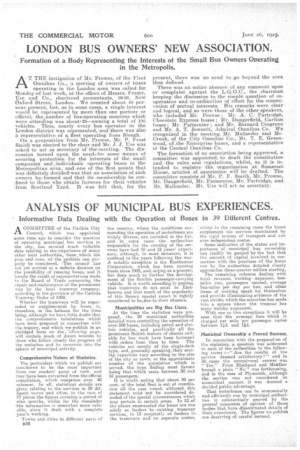ANALYSIS OF MUNICIPAL BUS EXPERIENCES.
Page 18

If you've noticed an error in this article please click here to report it so we can fix it.
• Informative Data Dealing with the Operation of Buses in 39 Different Centres.
ACOMMITTEE of the Carlisle City Council, which was appointed some time ago to consider the question of operating municipal bus services in the city, has secured much valuable data relating to thwexperience of many other local authorities, from.which the pros and cons, of the problem can properly be considered. The council has not yet arrived at a definite decision 'on the possibility of running buses, and it imaits the result of representations made to the Board of Trade concerning the repair and maintenance of the permanent way by the local tramway company., according to the provision of the Carlisle Tramway Order of 1898.
Whether the tramways will he superseded or supplemented by buses, is, therefore' in the balance for the time being, although we have little doubt that the' comprehensive tabulations which have been prepared in connection with the inquiry, and which. we publish in an abridged form on the.. "ollowing page, will contain much of direct interest to those who follow closely the progress of the motorbus and its incursion into the sphere of municipal activity.
Comprehensive Nature of Statistics.
The particulars which we publish are considered to be the most important from our readers' point of view, and they have been extracted from the official compilation, which comprises over 40 columns. In all, statistical details are given relating to the services in 39 different towns and cities, in the case or 17 places the figures covering a period of nine months, whilst for the remainder the information is somewhat more valuable, since it deals with a complete year's working.
. Towns and cities in different parts of
the country, where the conditions surrounding the operation of motorbuses are widely diverse, are included in the list., and in some cases the authorities responsible for the running of the services have had 10 and 12 years' experience, although, in most instances, it is confined to the years following the war. A notable exception is the Eastbourne Corporation, which has been running buses since 1903, and; acting as a pioneer, has done much to further the development of the flexible passenger-carrying vehicle. It is worth recording in passing that tramways do not exist in Eastbourne and that much of the popularity of this Sussex coastal resort is rightly considered to bettlue%to their absence.
Municipalities are Big Bus Users.
At the time the statistics were prepared, the 39 municipal authorities detailed were controlling the operation of over 500 buses, including petrol and electric vehicles, and practically all the prominent British inakers of chassis suitable for bus work have been favoured with orders from time to time. The vehicles are mostly of the single-deck type, and, generally speaking, their seating capacities vary according to the aim of the city or town, or the approximate number of the population which is served, the type finding most favour being that which seats between 30 and 34 passengers.
It hi worth noting that, about 30 per cent,, of the total fleet is out of commission all the year round, although this statement mnst not he considered denuded of the special circumstances which may pertain in certain areas. In 12 of the places enumerated the buses are run solely as feeders to existing tramway services, in 13 conjointly as feeders In the tramways and on separate routes,
whilst in the remaining cases the buses supplement the services maintained by the rigid system of transport and run over independent routes.
Some indication of the status and Unportance of municipal bus ownership can readily be gauged by the fact that the amount of capital involved in connection with the purchase of the buses run by the authorities detailed closely approaches three-quarter million sterling.
The remaining columns dealing with total revenue, working expenses; busmiles run, passengers carried, average bus-miles per day per bus, and other items of working speak for themselves and provide illuminating evidence of the vast strides which the motorbus has made into a sphere where the tramcar has many worthy exponents.
With one or two exceptions it will be seen that the average fare which is charged per mile per passenger varies between 1-kcl. and 1id.
Municipal Ownership a Proved Success.
In connection with the preparat'on of the statistics, a question was addressed to each of the authorities in the following terms :—" Are the results of the service deemed satisfactory? " and in 38 cases the unequivocal answer was "Yea." From Blackpool and Middlesbrough a plain " No ' was forthcoming, and in the ease of Plymouth, although the service was not considered an economical success, it was deemed a decided public advantage.
That motorbuses can be economically and efficiently run by municipal authori• ties is substantially proved by the general consensus of opinion, of those bodies that have disseminated details of their experience. The figures we publish are deserving Of careful perusal.




























